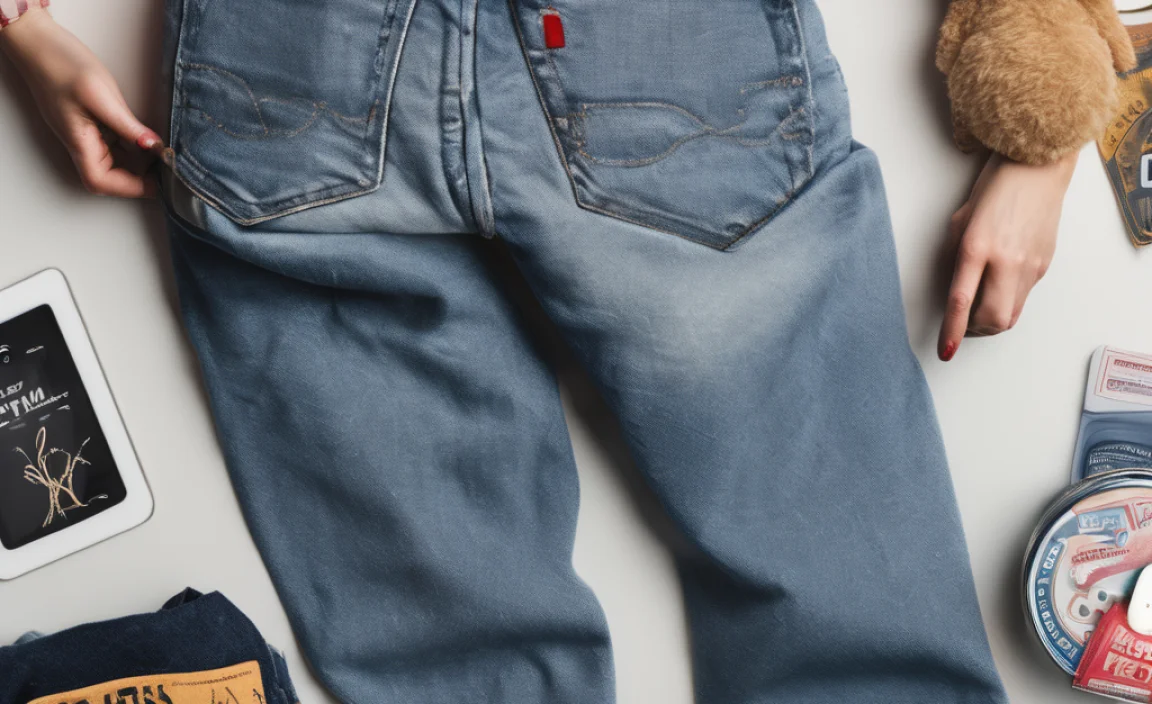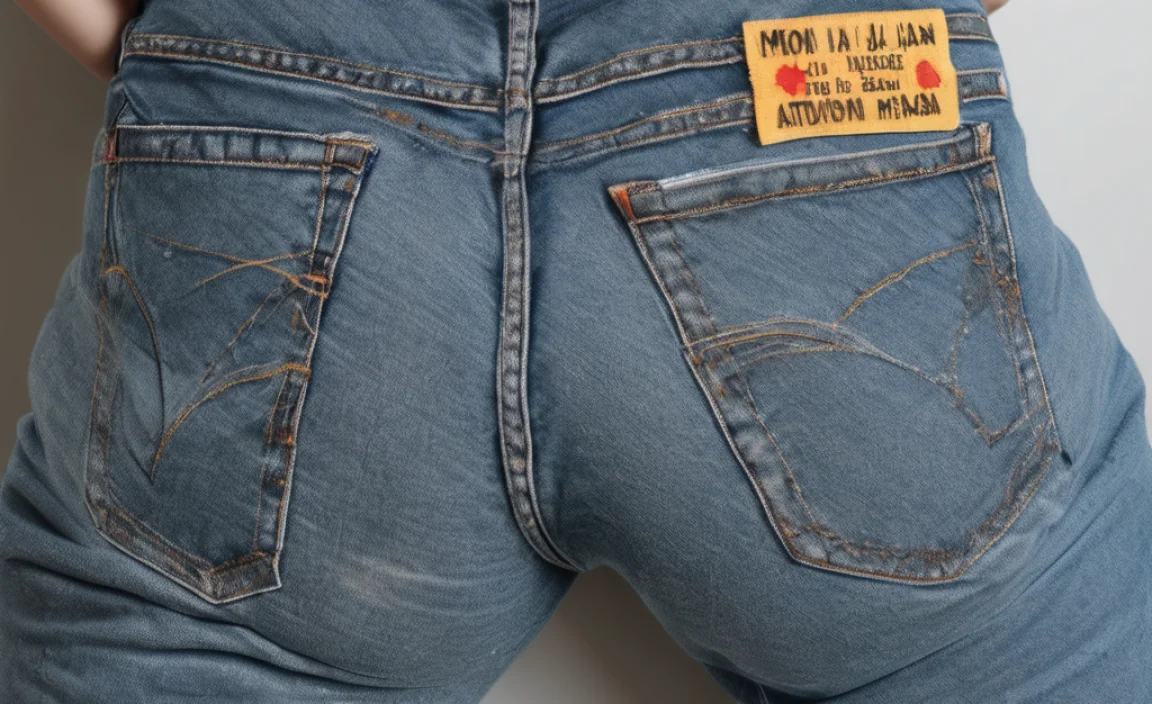Quick Summary: **Learn how to easily hem mom jeans using iron-on patches for a fast, no-sew fix. This simple hack gives your favorite jeans a perfect, custom length without any sewing skills or complicated tools. Get ready for a perfect fit in minutes!
Mom jeans are a wardrobe staple, loved for their comfortable, relaxed fit and vintage vibe. But sometimes, they’re just a little too long, drooping at the hem and making your outfit feel a bit ‘off.’ Traditional hemming can seem daunting if you don’t have a sewing machine or the knack for needle and thread. What if I told you there’s a super-simple, no-sew way to get that perfect length using just an iron and some clever patches? It’s true, and it’s easier than you think!
This method is perfect for anyone who wants their jeans to look great without spending a fortune at the tailor or wrestling with a sewing machine. We’ll walk through each step, making it totally foolproof. Get ready to rescue your favorite pair of jeans and give them a flawless finish that will have you feeling confident and stylish.
What You’ll Need

Before we dive into the magic of hemming, let’s gather our supplies. You might be surprised at how few things you need for this easy fix. Having everything ready makes the process smooth and quick.
Essential Materials:
- Mom Jeans: The stars of our show! Make sure they are clean and dry.
- Iron-On Hemming Patches: These are the secret weapon. You can find them at most craft stores or online. They come in various widths and colors. Choose a color that blends well with your jeans or a contrasting one for a stylistic statement.
- Fabric Scissors: Sharp scissors are crucial for a clean cut.
- Measuring Tape or Ruler: For accurate measurements.
- Iron: A standard household iron will do the job.
- Ironing Board: A stable surface for ironing.
- Pencil or Fabric Chalk: To mark your desired hemline.
- Pressing Cloth (Optional but Recommended): A thin piece of cotton fabric or parchment paper to protect your jeans and iron from direct heat.
Optional but Helpful:
- Flat Surface: A hard, flat surface like a table for precise marking and pressing.
- Old Towel: To place under the jeans on your ironing board for extra cushioning and heat distribution.
Understanding Iron-On Hemming Patches

Iron-on hemming patches are essentially strips of fusible interfacing with a strong adhesive on one side. When heat is applied, the adhesive melts and bonds the patch (and in this case, your fabric) together. They are designed to create a strong, durable hem that can withstand washing and wearing.
These patches are a game-changer for several reasons:
- No Sewing Required: This is the biggest advantage. You don’t need any special skills or equipment.
- Speed: The entire hemming process can take as little as 15-30 minutes.
- Durability: When applied correctly, they create a strong bond that holds up well.
- Adjustability: You can easily reposition the hem before heat sets it, allowing for adjustments.
You can find these in different forms. Some are pre-cut strips, while others are longer lengths you cut yourself. Read the package instructions, as application methods can vary slightly between brands. For a more permanent and professional look, you might consider fabric glue as an alternative, but iron-on patches offer unparalleled speed and ease for beginners.
Step-by-Step Guide to Hemming Mom Jeans

Ready to get started? Follow these simple steps to achieve a perfect hem for your mom jeans. We’ll break it down so it’s easy to follow along.
Step 1: Prepare Your Jeans
First, ensure your mom jeans are clean and completely dry. Any wrinkles or dirt can affect how the patch adheres. Lay your jeans flat on a clean, hard surface. Decide which leg you want to hem first. It’s often best to work on one leg at a time to ensure symmetry.
Step 2: Determine Your Desired Length
Put on your mom jeans and a pair of shoes you typically wear with them. Stand in front of a mirror. Adjust the jeans until the hemline hits where you want it. You can fold the excess fabric upwards to see how it will look once hemmed. Once you’ve found the perfect length, carefully take the jeans off without disturbing the fold.
Alternatively, lay the jeans flat on top of each other, lining up the waistbands and inseams. From the crotch seam, measure down to your desired hem length on one leg. Mark this point with your pencil or fabric chalk.
Step 3: Mark the Hemline
With the jeans still laid flat and the excess fabric folded up to your desired hemline, use your pencil or fabric chalk to mark a new, straight hemline. Make sure the line is even all the way across the leg. If you didn’t try them on, measure from the bottom edge of the pant leg upwards to your previous mark, and draw a line parallel to the original hem.
Tip: It’s often easier to mark the length on the inside of the jean leg to hide the chalk marks. For a clean finish, aim for a hem that falls just at or slightly above your ankle bone.
Step 4: Cut Off Excess Fabric (Optional but Recommended)
This step is optional but can give a cleaner finish. If you want a more tailored look and are confident in your length, carefully cut off the excess fabric below your marked hemline. Leave about ½ to 1 inch of fabric below your marked line. This extra fabric will be folded up to create the new hem. If you prefer to keep the original finished hem edge for a more casual, raw-hem look, skip this step and proceed to Step 5, adjusting the patch placement accordingly.
Step 5: Prepare the Iron-On Patch
Read the instructions on your specific hemming patch package. Typically, you’ll need to cut a piece of the patch that is slightly wider than the width of your jean leg at the hem and long enough to go around the entire circumference. Some patches are pre-cut so you can just apply them. If you’re using a roll, measure and cut your patch. You usually want the patch to run along the inside of the jean leg, just above where you want the new hem to sit.
Important Note: Ensure the sticky/fusible side of the patch is facing down onto the inside of the jean leg, and the fabric side of the patch is facing outwards.
Step 6: Fold the Hem
Now, fold the bottom edge of the jean leg upwards towards the inside following your marked hemline. If you cut off excess fabric, fold up the amount you want to create the hem (e.g., 1 inch). If you kept the original hem, fold it up so the original finished edge meets your marked line. Press this fold firmly with your iron to create a crisp crease. This crease will act as a guide for the patch.
Step 7: Apply the Iron-On Patch
Place your cut iron-on patch against the inside of the folded hem, ensuring that the adhesive side of the patch is facing the fabric of the jeans, and the fabric side of the patch is facing outwards. The patch should be positioned to hold your folded hem in place.
For Best Results:
- Lay the jeans flat on your ironing board.
- Place the patch on the inside of the folded hem so it covers the folded edge and adheres to both layers of the jean fabric.
- If using a pressing cloth, place it over the patched area.
- Set your iron to the appropriate temperature as per the patch instructions (usually a medium-high setting, NO steam).
- Press the iron firmly onto the patch and surrounding fabric for the recommended time (typically 10-20 seconds).
- Work your way around the entire circumference of the hem, ensuring the patch is well adhered.
Table: Iron Temperature Guide (General)
| Fabric Type | Iron Setting | Time (seconds) |
|---|---|---|
| Denim / Cotton Blends | Medium-High (Cotton/Linen) | 10-20 |
| Synthetic Blends (Check patch instructions carefully) | Medium (Synthetics) | 8-15 |
Always refer to your specific iron-on patch manufacturer’s instructions for the most accurate temperature and timing. Testing on a scrap piece of fabric is recommended.
Step 8: Let It Cool and Check
Allow the hem to cool completely before checking its security. Once cooled, gently tug at the hem to ensure it’s firmly attached. If any part feels loose, repeat the ironing process on that section, making sure to apply enough heat and pressure.
Step 9: Repeat for the Other Leg
Once you’re happy with the first hem, lay your jeans flat again. Carefully measure the first hemmed leg and ensure the second leg matches exactly. Repeat steps 1 through 8 on the second leg to create a perfectly matched pair of hemmed mom jeans.
Step 10: Final Press for a Clean Finish
After both legs are hemmed and secured, you can give the entire hem area a final press from the outside (with a pressing cloth) for a sharp, finished look. This helps to ensure the hem lies flat and looks as professional as possible.
Pros and Cons of the Iron-On Patch Hack

Like any DIY method, this iron-on patch hack has its advantages and disadvantages. Understanding these will help you decide if it’s the right solution for your needs.
Pros:
- Speed and Ease: The most significant benefit is how quickly and simply you can achieve a hemmed effect without sewing.
- Cost-Effective: Much cheaper than taking them to a tailor.
- Beginner-Friendly: Requires no prior sewing experience.
- Customization: Allows you to easily adjust the length to your exact preference.
- Mess-Free: No threads, needles, or sewing machine to worry about.
- Reversible (to an extent): In some cases, with careful steaming and prying, the patch can be removed if you change your mind, though this can be tricky and may leave residue.
Cons:
- Durability Concerns: While generally durable, the bond can weaken over time with frequent washing and drying, especially in high heat.
- Visible Seam: The patch itself can sometimes be slightly visible from the outside, depending on the color and thickness of the patch and the denim.
- Stiffness: Some patches can make the hem area feel a bit stiff.
- Potential for Damage: Overheating or holding the iron too long can scorch the denim or melt synthetic threads.
- Not for All Fabrics: Best suited for sturdy fabrics like denim. May not work well on very lightweight or delicate materials.
- Ironing Surface: Requires access to an iron and ironing board, which might not be readily available to everyone.
For a quick fix, a casual look, or for jeans you don’t wear every single day, this hack is fantastic. If you’re aiming for a perfectly tailored, invisible hem that will last for years through constant wear and washing, a traditional sewing method or professional alteration might be a better choice.
Tips for the Best Results

To ensure your iron-on hemmed mom jeans look great and last longer, keep these tips in mind:
- Read the Patch Instructions: Every brand is slightly different. Follow their specific guidelines for heat, time, and application.
- Pre-Wash Jeans: Always start with clean, un-shrunk jeans to ensure the hem stays consistent.
- Test First: If you’re unsure about the heat setting or how the patch will adhere, test it on an inconspicuous area or a scrap piece of similar denim first.
- Use a Pressing Cloth: This protects your jeans from direct heat and prevents potential scorching or shine marks. It also helps distribute heat evenly. You can use a thin cotton cloth, a pillowcase, or parchment paper.
- No Steam! For most iron-on adhesives, steam is the enemy as it can prevent proper bonding. Ensure your iron is set to ‘dry’ or ‘no steam’.
- Apply Even Pressure: Press down firmly and evenly with the iron. Don’t just glide it. Hold it in place for the recommended duration.
- Allow Cooling: Resist the urge to tug at the hem immediately. Let it cool completely for a few minutes to allow the adhesive to fully set.
- Consider the Color: If you want the hem to be subtle, choose a patch color that matches your jeans. For a decorative edge, choose a contrasting color.
- For Durability: When washing your hemmed jeans, turn them inside out, use a cold or warm wash cycle, and consider air-drying or tumble-drying on low heat. This prolongs the life of any adhesive.
- Professional Finish: After the patch is applied and cooled, a final exterior press (with a pressing cloth) can give the hem a sharper, more finished look.
Frequently Asked Questions (FAQ)
Q1: Will iron-on patches hold up to washing and drying?
A1: Yes, generally they will. However, for best results and to prolong the life of the hem, it’s recommended to wash your jeans inside out in cold or warm water and tumble dry on a low heat setting, or air dry. High heat can weaken the adhesive over time.
Q2: Can I remove iron-on hem patches if I don’t like them?
A2: It can be difficult, but sometimes possible. You can try using a damp cloth and a hot iron (with a pressing cloth) to reheat the adhesive and gently pry the patch off. Be aware that this process might leave residue on your jeans or even damage the fabric if not done carefully. It’s best to be sure of your length before applying!
Q3: How much fabric should I fold up for the hem?
A3: This depends on your desired look and the thickness of the patch. A common fold is about ½ to 1 inch. This gives enough fabric for the patch to adhere well and creates a subtle hem. For a more dramatic cuff, you might fold more, but ensure the patch can secure it.
Q4: Can I use iron-on patches on all types of jeans?
A4: Iron-on patches work best on sturdy, tightly woven fabrics like traditional denim. They may not adhere well to very thin, stretchy, or delicate fabrics. Always check the patch manufacturer’s recommendations and test on a small, inconspicuous area if unsure.
Q5: What temperature should my iron be for iron-on patches?
A5: This varies by patch brand, but generally, a medium-high setting (around 300-325°F or











